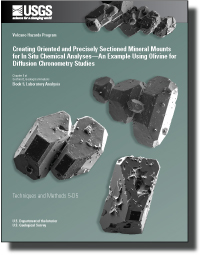Creating Oriented and Precisely Sectioned Mineral Mounts for In Situ Chemical Analyses—An Example Using Olivine for Diffusion Chronometry Studies
Links
- Document: Report (12 MB pdf) , HTML , XML
- Download citation as: RIS | Dublin Core
Abstract
Diffusion chronometry is now a widely applied methodology for determining the rates and timescales of geologic processes from the chemical zoning observed in minerals. Despite the popularity of the method, several challenges still remain during its application, including: (1) the random sectioning of minerals either in thin sections or grain mounts in which both off-center and oblique sections contribute substantial uncertainty to modeled timescales and (2) diffusion anisotropy needs to be accounted for in models, which generally requires determining the principal crystallographic axes of the mineral using electron backscatter diffraction, a technique that is both challenging and limiting because few scanning electron microscopes have an electron backscatter detector. This guide developed by the U.S. Geological Survey focuses on a step-by-step methodology for mounting individually oriented minerals that are sectioned through their cores prior to polishing for analytical work. Using this technique, one can significantly reduce the uncertainties associated with off-center sections and minimize or completely remove the need for determining crystallographic orientation via electron backscatter diffraction analyses. This report is presented as a guide for using the technique on olivine crystals but can be applied to any minerals that can be extracted for analysis. Two variations of the methodology are included here: (1) The individual crystal method that entails mounting individually sectioned single crystals and crystal groups and (2) the whole mount method in which multiple single crystals or crystal clusters are mounted and sectioned at the same time.
Suggested Citation
Lynn, K.J., and DeSmither, L.G., 2023, Creating oriented and precisely sectioned mineral mounts for in situ chemical analyses—An example using olivine for diffusion chronometry studies: U.S. Geological Survey Techniques and Methods, book 5, chap. D5, 36 p., https://doi.org/10.3133/tm5D5.
ISSN: 2328-7055 (online)
Table of Contents
- Preface
- Acknowledgments
- Abstract
- Introduction
- Sample Preparation and Picking
- Orienting, Sectioning, and Mounting Individual Single Crystals or Crystal Groups (Individual Crystal Method)
- Orienting, Mounting, and Sectioning Multiple Single Crystals or Crystal Clusters (Whole Mount Method)
- Proof of Concept
- Method Summary
- References Cited
- Appendix 1. Electron Microprobe Analyses of Standard San Carlos Olivine Reported as Weight Percent Oxides
- Appendix 2. Electron Microprobe Profiles of Olivine Samples
| Publication type | Report |
|---|---|
| Publication Subtype | USGS Numbered Series |
| Title | Creating oriented and precisely sectioned mineral mounts for in situ chemical analyses—An example using olivine for diffusion chronometry studies |
| Series title | Techniques and Methods |
| Series number | 5-D5 |
| DOI | 10.3133/tm5D5 |
| Publication Date | November 08, 2023 |
| Year Published | 2023 |
| Language | English |
| Publisher | U.S. Geological Survey |
| Publisher location | Reston, VA |
| Contributing office(s) | Volcano Science Center |
| Description | ix, 36 p. |
| Online Only (Y/N) | Y |


